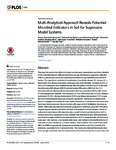Please use this identifier to cite or link to this item:
http://www.alice.cnptia.embrapa.br/alice/handle/doc/1018114| Title: | Multi-Analytical approach reveals potential microbial indicators in soil for sugarcane model systems. |
| Authors: | NAVARRETE, A. A.  DINIZ, T. R.   BRAGA, L. P. P.   SILVA, G. G. Z.   FRANCHINI, J. C.   ROSSETTO, R.   EDWARDS, R. A.   TSAI, S. M.   |
| Affiliation: | ACACIO APARECIDO NAVARRETE, CENA; TATIANA ROSA DINIZ, CENA; LUCAS PALMA PEREZ BRAGA, CENA; GENIVALDO GUEIROS ZACARIAS SILVA, SAN DIEGO STATE UNIVERSITY; JULIO CEZAR FRANCHINI DOS SANTOS, CNPSO; RAFFAELA ROSSETTO, APTA; ROBERT ALAN EDWARDS, SAN DIEGO STATE UNIVERSITY - ARGONNE NATIONAL LABORATORY; SIU MUI TSAI, CENA. |
| Date Issued: | 2015 |
| Citation: | Plos One, [S. l.], Jun. 2015. |
| Pages: | 19 p. |
| Description: | This study focused on the effects of organic and inorganic amendments and straw retention on the microbial biomass (MB) and taxonomic groups of bacteria in sugarcane-cultivated soils in a greenhouse mesocosm experiment monitored for gas emissions and chemical factors. The experiment consisted of combinations of synthetic nitrogen (N), vinasse (V; a liquid waste from ethanol production), and sugarcane-straw blankets. Increases in CO2-C and N2O-N emissions were identified shortly after the addition of both N and V to the soils, thus increasing MB nitrogen (MB-N) and decreasing MB carbon (MB-C) in the N+V- amended soils and altering soil chemical factors that were correlated with the MB. Across 57 soil metagenomic datasets, Actinobacteria (31.5%), Planctomycetes (12.3%), Deltaproteobacteria (12.3%), Alphaproteobacteria (12.0%) and Betaproteobacteria (11.1%) were the most dominant bacterial groups during the experiment. Differences in relative abun- dance of metagenomic sequences were mainly revealed for Acidobacteria, Actinobacteria, Gammaproteobacteria and Verrucomicrobia with regard to N+V fertilization and straw re- tention. Differential abundances in bacterial groups were confirmed using 16S rRNA gene- targeted phylum-specific primers for real-time PCR analysis in all soil samples, whose re- sults were in accordance with sequence data, except for Gammaproteobacteria. Actino- bacteria were more responsive to straw retention with Rubrobacterales, Bifidobacteriales and Actinomycetales related to the chemical factors of N+V-amended soils. Acidobacteria subgroup 7 and Opitutae, a verrucomicrobial class, were related to the chemical factors of soils without straw retention as a surface blanket. Taken together, the results showed that MB-C and MB-N responded to changes in soil chemical factors and CO2-C and N2O-N emissions, especially for N+V-amended soils. The results also indicated that several taxo- nomic groups of bacteria, such as Acidobacteria, Actinobacteria and Verrucomicrobia, and Competing Interests: The authors have declared that no competing interests exist. their subgroups acted as early-warning indicators of N+V amendments and straw retention in sugarcane-cultivated soils, which can alter the soil chemical factors. |
| Thesagro: | Cana de açúcar Microbiologia do solo |
| NAL Thesaurus: | Sugarcane Soil biology |
| DOI: | 10.1371/journal.pone.0129765 |
| Type of Material: | Artigo de periódico |
| Access: | openAccess |
| Appears in Collections: | Artigo em periódico indexado (CNPSO)  |
Files in This Item:
| File | Description | Size | Format | |
|---|---|---|---|---|
| MultiAnalyticalApproachRevealsPotential.pdf | 1.68 MB | Adobe PDF |  View/Open |









